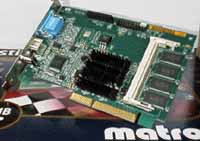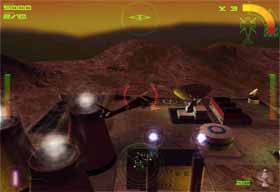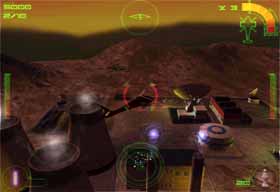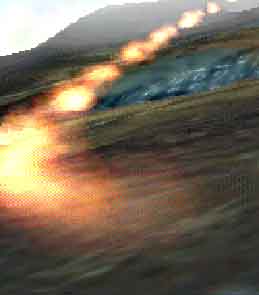
Original Link: https://www.anandtech.com/show/189
| Work and play, according to virtually all video card manufacturers, can't coexist. There will always be the leading gaming solution, and the leading business solution, never a product tailored to perform equally well in both arenas. While one may argue that it is a simple marketing tactic to boost sales, the bottom line is that there is a product suited for every need you may have. But when does a product, or in this case, a video card, leave the segregated work/play theory behind and truly become a one size fits all solution? |  |
| This is the topic that has been surrounding two particular video accelerators, both from Matrox Graphics, and both based on the same G200 chipset, what makes them different? Unfortunately there is very little that sets the two apart aside from what the naked eye can perceive. | |
Originally thought to be the best 2D solution for any home/desktop system, the Matrox Millennium which was later succeeded by the Millennium II, brought a certain level of quality and performance to the market that was left unparalleled by any other manufacturer for quite some time. Carrying on the tradition of the Millennium name, when Matrox announced the release of their G200 graphics chipset, they released two products. One geared towards the home user market, the Mystique G200, and one more fit for the Business market, rightfully entitled the Millennium G200.
In the past that which separated the Millennium from the Mystique series of graphics accelerators was sheer performance in addition to differences in hardware specifications and software bundles. The reason for this was usually courtesy of a three fold solution: 1) differences brought on by the use of two different Matrox chipsets, 2) differences brought on by the use of a different speed RAMDAC, and 3) differences brought on by the use of different types of video memory. This time around, instead of carrying on tradition with that three fold solution to making a Millennium differ from a Mystique, Matrox chose to simply outfit the Millennium G200 with a faster RAMDAC (the component which directly determines the refresh rate and eventually, the 2D image quality) and faster, yet more expensive video memory.
Here's where things get a bit complicated, at the heart of both the Millennium G200 and Mystique G200 is the same graphics chipset, the Matrox G200. There is absolutely no difference between the two cards on the lowest of levels, including minimum performance. The Mystique branches off into the home market by adding support for TV-Output, while compensating for the cost of the addition of a TV-Out feature by using a 230MHz RAMDAC and SDRAM for the video memory. Like a teenager looking to stand out at a party, the Millennium G200 separates itself by dressing out with a 250MHz RAMDAC (as opposed to the 230MHz RAMDAC on the Mystique) and picking up a set of high speed SGRAM to replace the slower SDRAM present on the Mystique's design. The cost of these two additions does come at a premium price to the user. In order to gain the extra performance and image quality provided for by the SGRAM and the 250MHz RAMDAC while maintaining an equal price level between both cards as to not unevenly balance sales, the Millennium G200 loses the high quality TV-Output feature that the Mystique G200 boasts.
Now before you approach any quick decisions, a few items must be cleared up. First of all, will you notice the difference between the 250MHz RAMDAC on the Millennium and the 230MHz RAMDAC on the Mystique? That depends on the size of your monitor, and the resolution/refresh rate you plan on running it at. As long as you don't plan on using resolutions higher than 1280 x 1024, the difference in image quality (2D) between the Millennium and the Mystique G200 boards is marginal. If you plan on running at resolutions higher than that, such as 1600 x 1200, then you may want to opt for the Millennium over the Mystique. In which case you won't have to worry about the loss of a TV-Output port since the quality of a monitor capable of legibly running at 1600 x 1200 is much better than that of a standard TV. Which brings us to the second point, that in spite of the quality of the TV-Output on the Mystique G200, the quality of an image displayed on a NTSC or PAL TV is incredibly poor in comparison to a good computer monitor simply because of the attainable resolutions on a monitor vs those on a TV. For anyone with a 17" or greater sized monitor, the TV-Output feature will probably be more of a useless tool than a unique feature. If you happen to be limited to a 14" or 15" display, then the Mystique G200 will become a more appetizing solution because of its TV-Output.
Click here to find lowest prices on this product.
General Specifications
- 250MHz Integrated RAMDAC
- 8MB SGRAM Upgradable to 16MB
- Full AGP 2X Support
- 128-DualBus Architecture (Dual 64-bit Independent Buses)
- Dual Command Pipelining
- 32-bpp True Color Rendering & Z-Buffering
- Per Pixel Trilinear Filtering
Advanced 3D Feature Set
- Alpha-Blending
- Bi-linear Filtering
- Tri-linear MIP-Mapping
- Fogging
- Anti-Aliasing
- Specular Highlighting
3D Graphics Performance
- 1.5M triangles/second
- 100M pixels/second
Supported Display Modes
Matrox Millennium G200 8MB AGP |
||||
| - | Colors | Refresh Rate | ||
Resolution |
2D | 3D | Vertical (Hz) | Horizontal (KHz) |
| 1920x1200 | 16M | --- | 60-76 | 75-95 |
| 1800x1440 | 16M | --- | 60-70 | 89-104 |
| 1600x1200 | 16M | 65K | 60-90 | 75-113 |
| 1280x1024 | 16M | 16M | 60-100 | 64-107 |
| 1152x864 | 16M | 16M | 60-120 | 54-110 |
| 1024x768 | 16M | 16M | 60-140 | 48-113 |
| 800x600 | 16M | 16M | 60-180 | 38-114 |
| 640x480 | 16M | 16M | 60-200 | 31-102 |
Supported Operating Systems
- Microsoft Windows 9x
- Microsoft Windows NT (4.0 or higher)
Supported Graphics APIs
- Direct3D
- OpenGL
Click here to find lowest prices on this product.
Taken from Mystique G200 Review
To fully understand where the performance and image quality come from when looking at a video card such as the Millennium G200, we must turn our attention to the heart of the card, the chipset - in this case, the Matrox G200.
128-bit DualBus
Imagine that you are on an 8-lane highway. The 8-lanes of this highway allow for more traffic to move from one end of it to the other, however there is a catch. The cars on the highway can only be moving in one direction at a time, meaning that all the cars must either be moving up the highway or down it but not both at the same time (all 8-lanes move in the same direction). Consider that the limited functionality of an internal 128-bit Data Bus when applied to video cards, on any given CPU clock cycle the data being transferred via the internal 128-bit Data Bus can only flow in one direction (to the graphics engine). On the following clock cycle the data can be transferred down the bus in the other direction (from the graphics engine). While this approach does have its benefits, when dealing with 2D images and bitmaps where the data that must be transferred down the bus remains quite small (less than 128-bits) there is a much more efficient way of approaching this.
Let's take that highway example from above, now instead of making that highway an 8-lane highway let's split it up into a 4-lane going and a 4-lane coming highway. Meaning that at the same time 4 lanes of cars can be traveling on the highway in the opposite direction of 4 lanes of cars on the other side of the highway (4 lanes can be leaving the city while 4 lanes can be entering). If there is no need for 8 lanes to be open for transportation in any one direction then the first 8-lane highway wouldn't be as efficient as this modified 4/4-lane highway. The same theory applies to the Matrox G200.
Instead of occupying the entire width of a 128-bit bus to transfer data in 64-bit chunks why not create a dual 64-bit setup with one bus dedicated to sending data to the graphics engine and the other dedicated to receiving data from it. This is what the G200's 128-bit DualBus architecture is, in essence it is 2 64-bit buses offering the same combined bandwidth as a single 128bit data bus while allowing for data to be sent in parallel to and from the graphics engine. It is this technology that gives the G200 the edge over the competition in its 2D performance, allowing for 24-bit desktop color depths at a faster level of performance than most of the competition can do at 16-bit color depths.
3D Performance and Image Quality
What good is a 2D combo card without the powerful 3D punch to back up its dimension crippled counterpart in performance? The G200 doesn't lose any points here either, with a 100 million pixels/second fill rate one would expect the G200 to be able to hold its ground fairly well in 3D games and applications. You must keep in mind that the G200 was never intended to be a Voodoo2-killer rather a lower cost alternative for those who don't have the funds to accommodate a single Voodoo2 + 2D accelerator which justifies the sub-Voodoo2 levels of performance you'll be seeing from the G200.
One advantage, outside of price, that the G200 holds over the Voodoo2 as well as all other 2D/3D combo cards is its top notch image quality. Using Vibrant Color Quality (VCQ) Rendering the G200 is capable of rendering images in 32-bits per pixel color (meaning 8-bits for red, green, blue and alpha) even if the rendering is set to 16-bpp the internal calculations and accuracy is done in 32-bpp and dithered down to 16-bpp upon displaying the images. Matrox illustrated this difference quite nicely on their VCQ Whitepaper which is summarized beautifully by the two screenshots they provided below:
|
|
The difference is clearly noticable in the 32-bit Rendered Incoming screenshot, whether or not this will mean anything to you as the frames are flying past you while playing is up to you to decide, however once you experience the G200's image quality you'll never want to go back.
Another excellent example Matrox used was the following screenshot comparison of a 32-bit texture rendered in both 32-bits and 16-bits to visually illustrate the difference between the G200 and a chipset only capable of 16-bit Rendering in a 32-bit scenario.
|
|
As more and more games begin to use 32-bit textures you can expect to notice differences like the one illustrated above between a graphics card capable of 32-bit rendering and one limited to 16-bit rendering. Since the number of games that make use of 32-bit textures is extremely low this feature doesn't carry as much weight as performance does, for example. But for now you can rest assured knowing that one day you'll be able to make more use of the G200's advanced rendering capabilities - better safe than dithered in this case.
Click here to find lowest prices on this product.
Classic of most Matrox products, the Millennium G200's installation process couldn't be easier. On both the Super7 and Pentium II BX test systems AnandTech used for the compatibility testing, the Millennium G200 installed without a hitch. Installing over previous video card drivers posed no compatibility or conflict problems for either of the test systems, and using the Millennium's bundled driver installation CD, all video modes as well as the new Matrox Display Properties Control Panel were available for selection. As with previous Matrox graphics solutions, you can expect incredible driver support for the Millennium G200 to carry you through your next video upgrade.
The card itself, albeit a tad bit on the hot side during operation (some users have reported the need for a fan to be placed over the heatsink) is very well designed and features a SO-DIMM (Small Outline - Dual Inline Memory Module) connector in addition to the feature connectors which can be used for an upgrade to Video-In and DVD Decoder options. The Millennium G200 board does show the outline for the placement of a 3-pin fan connector, however the absence of the actual connector and a fan can probably be attributed to efforts to drive the cost of the product even lower. It would've been nice had Matrox included the fan, as many users wouldn't mind paying an extra $10 for more stable operation, but you can't always have it all...that would defeat the purpose of competition.
The SO-DIMM connector on the board allows for a seamless upgrade of the onboard SGRAM from 8MB to 16MB, the performance difference between 8MB and 16MB boards is barely noticable. The only reason one would opt to go with a 16MB configuration would be to take advantage of the Triple Buffering features of the Millennium G200. Using Triple Buffering in games that support the feature will yield a comfortable increase in performance. Ziff Davis' 3D Winbench 98, although it may not be a good platform to compare individual video cards, came in quite handy in illustrating the performance increase triple buffering provides. By using a triple buffer, as opposed to a double buffer when rendering a 3D scene, performance increases by approximately 30%. For now, there is no reason to wait for a 16MB card, but the SO-DIMM connector allows you to keep that 8MB upgrade as an option for the future when more games will take advantage of triple buffering. Imagine that, being able to upgrade a product instead of having to purchase an entirely new one...a new philosophy or the weakening of a marketing strategy? You decide ;)
The Millennium G200, unlike its "home PC" counterpart, comes with a fairly professional software bundle consisting of Picture Publisher, Simply 3D, Netscape Communicator, and PointCast Client. Unfortunately, due to its target market, the Millennium G200 isn't shipping with the D3D Wrapper that Matrox provided to tide us over until the release of their OpenGL ICD. While most would've preferred that Matrox leave the decision up to us, the users, as to whether or not we needed a D3D Wrapper, the OpenGL ICD should be just a few more weeks away from its debut so there isn't too much to complain about. Matrox is also working on drivers with 3DNow! support for K6-2 users, as soon as those are released expect to see a small update to this review with new benchmarks.
Click here to find lowest prices on this product.
The Slot-1 Pentium II Test System AnandTech used was configured as follows:
Intel Pentium II 400 on an ABIT BX6 Motherboard
64MB PC100 SDRAM
Western Digital 5.1GB Ultra ATA Hard Drive
AOpen 32X IDE CD-ROM Drive
Windows 98 with all of the latest patches/drivers installed
The benchmark suite consisted of the following full version game titles
Forsaken - Running the Nuke Demo
Turok Dinosaur Hunter run with the '-benchmark' option
Quake 2 v3.14 using Demo1.dm2 and Brett "3 Fingers" Jacobs Crusher.dm2 demo
Ziff Davis' Winbench 98 was also used to test 2D performance
VSYNC was disabled during AnandTech's tests and was done so by using the following procedure:
Using the Windows 98 Registry Editor click on HKEY_LOCAL_MACHINE, then Software, then Matrox, then Current Settings and add the following string value with a value of 0 (use a value of 1 to enable VSync): Flip On Vblank
Thanks to Craig from Cyrellis for pointing that out to me.
The performance difference between the Millennium G200 and the Mystique G200 is negligible, which would make re-running every single test that was used in the Mystique G200 Review redundant. For more benchmarks visit the AnandTech Mystique G200 Review. The purpose of this performance comparison is to illustrate the performance difference between the Millennium and Mystique G200 cards.
Ziff Davis Winbench 98 - 2D Performance - 1024 x 768 x 16-bit Color |
||
| - | Business | High End |
| - | Windows 98 - P2 400 | Windows 98 - P2 400 |
| Matrox Millennium G200 - 8MB | 211 | 269 |
| Matrox Millennium G200 - 16MB | 209 | 269 |
| Matrox Mystique G200 - 8MB | 207 | 269 |
Pentium II Test System - Quake 2 - Open GL Performance |
||
| - | Timedemo - 640 x 480 | |
| - | demo1.dm2 (Millennium/Mystique) |
crusher.dm2 (Millennium/Mystique) |
| G200 Pentium II - 400 | 42.9/41.3 | 28.6/28.3 |
| - | Timedemo - 800 x 600 | |
| - | demo1.dm2 | crusher.dm2 |
| G200 Pentium II - 400 | 29.1/29.0 | 23.5/23.3 |
| - | Timedemo - 1024 x 768 | |
| - | demo1.dm2 | crusher.dm2 |
| G200 Pentium II - 400 | 19.8/18.1 | 17.0/15.8 |
If you don't mind giving up the TV-Output feature, the Millennium G200 is basically a Mystique G200 with a couple extra performance percentage points under the hood. The main differences between the two cards seem to exist at higher resolutions, as the Timedemo scores at 1024 x 768 differ by around 1 - 2 fps, while that doesn't seem like much, considering that the Millennium G200 is the same price as the Mystique G200, it's like getting those 1 - 2 fps free of charge. If you're not going to use the TV-Output, then why not benefit from the performance increase?
Pentium II Test System - Triple Buffering Performance Increase |
|
| - | ZD 3D Winbench 98 - 800 x 600 x 16-bit Color |
| -Matrox Millennium G200 - 16MB Pentium II 350 |
3D Winbench 98 Score |
| Double Buffered Score | 587 |
| Triple Buffered Score | 758 |
Triple Buffering seems very promising on paper, let's just wait for some more gaming support before jumping on that 16MB bandwagon just yet.
Pentium II Test System - Turok - Direct3D Performance |
|
| - | Frame Rate - 640 x 480 |
| - | TMark (Millennium/Mystique) |
| G200 Pentium II - 400 | 109.5/107.0 |
| - | Frame Rate - 800 x 600 |
| - | TMark (Millennium/Mystique) |
| G200 Pentium II - 400 | 103.1/99.7 |
Click here to find lowest prices on this product.
The Matrox Millennium G200 is definitely a winner, as long as you don't mind the absence of a TV-Output port the Millennium G200 is the clear winner over the Mystique G200 as it offers the same features as the G200, with a little performance boost. Provided that the professional bundle doesn't bother you, this reviewer would choose the Millennium G200 over the Mystique any day. For those of you confined to smaller monitors, the Mystique may be more of your game, and of course, if you're purely into 2D performance and business applications then stop reading about the G200 and pick up a Millennium II.











